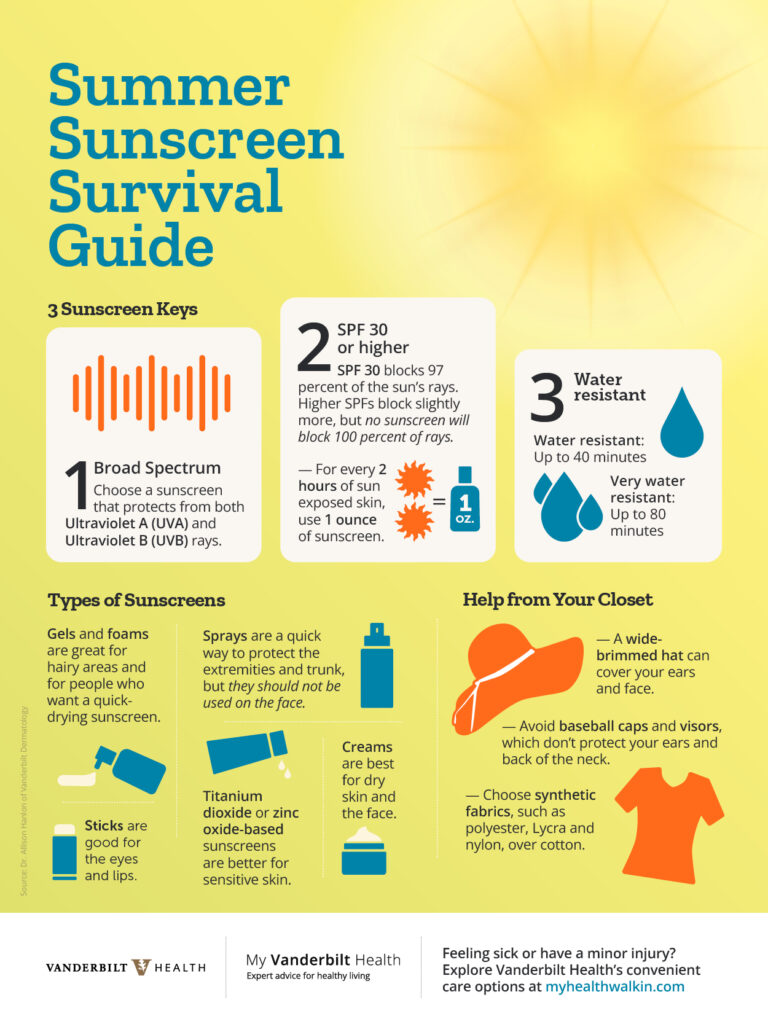A Vanderbilt doctor shares what you need to know to stay covered this season.
Biking Nashville’s greenways, hiking to a beautiful waterfall, hanging out in Centennial Park — there are countless great activities to enjoy outside this summer. But no matter what you do when you head outdoors, you’ll want to use sunscreen correctly to protect yourself from the harmful rays of the sun.
Using sunscreen is one of the best ways to protect your skin from the sun’s damaging effects, which can not only cause premature aging and sunburn, but can also increase the risk of skin cancer.
“Skin cancer is the most common form of cancer in the United States,” said Dr. Allison Hanlon of Vanderbilt Dermatology. “And anyone can get it, regardless of age, gender or skin tone, which means that everyone should be wearing sunscreen when they head outside.”
Hanlon walked us through the top sunscreen tips to remember when it comes to choosing and applying a sunscreen — here’s what you need to know.
What is the best sunscreen?
When choosing a sunscreen, look for three key statements on the label:
- Broad-spectrum sunscreen;
- SPF 30 or higher; and
- Water resistant.
“A broad-spectrum sunscreen protects from both Ultraviolet A (UVA) and Ultraviolet B (UVB) rays, both of which are associated with skin cancer. UVA rays can pass through window glass, whereas UVB are blocked by windows” Hanlon explained. “Both UVA and UVB can cause skin cancer, but UVA is more commonly associated with the development of premature skin aging such as wrinkles and sunspots, while UVB typically cause sunburns. A broad-spectrum sunscreen will protect against both UVA and UVB rays, which is important for good skin care and health.”
Water resistant and very water resistant are important label statements to look for in choosing a sunscreen. Previous terms like waterproof and sweatproof sunscreens are now banned as the FDA found them to be misleading. Water resistant means that the sunscreen is effective for up to 40 minutes in water/sweating, while very water resistant is effective for up to 80 minutes in water/sweating.
“I recommend to my patients that even if they were wet for a shorter period than listed on the labeling, to reapply their sunscreen after swimming, sweating or towel drying,” Hanlon said.
What SPF is best?
The American Academy of Dermatology recommends an SPF of 30 or higher, which blocks 97% of the sun’s rays. Higher number SPFs block slightly more of the sun’s rays, but there is no sunscreen that will block 100% of the sun’s rays.
“Keep in mind, though, whether the SPF is 30 or 100, the sunscreen lasts for about the same duration. So, a higher number SPF does not equal a longer time of protection. Save your money with an effective SPF of 30,” Hanlon advised.
How much sunscreen do I really need?
The recommended amount for application is a shot glass full of sunscreen every two hours when outside and more often after swimming or sweating.
“Many of us do not apply enough sunscreen to effectively protect our skin,” Hanlon said. “The shot glass rule helps guide how much to apply when at the beach, pool or lake. I recommend setting your phone timer to remind you to reapply or purchase UV silicone bracelets that change color when it is time to reapply — these are a fun option for kids and allow you to unplug from your phone.”
Is it better to use a spray-on sunscreen or a lotion-based product?
While some protection is certainly better than none, Hanlon said, physically applying a lotion or cream typically offers more robust coverage than an aerosol spray and may prevent exposure to benzene, a chemical known for having the potential to cause cancer.
“In recent years, some aerosolized sunscreens have been recalled due to the presence of benzene,” she explained. “It was not the sunscreen itself but certain compounds in the spray propellant that may mix to form benzene.”
Does sunscreen go bad?
In short, yes. Check the dates on the sunscreen you already have at home, and discard any with expired dates. If there is no expiration date on the bottle, there are some signs that the sunscreen may no longer be good. Obvious changes in the color or texture of the sunscreen mean the sunscreen is no longer protective.
What kind of clothes should I wear to protect myself from the sun?
“Sun-protective clothing is more available now and is a great option not only for swimming but also other outdoor activities — gardening, golf and hiking,” Hanlon said. “Some fabrics even wick away sweat so despite the long sleeves, the shirts can be cooling.”
The weave of the fabric is important in determining how protective the clothes are from the sun. Raising the fabric to a light and seeing how much light is transmitted through the fabric can indicate how protective the clothing is from the sun’s rays.
Synthetic fibers such as polyester, Lycra and nylon are more protective than bleached cottons or semi-synthetic fabrics like rayon. Clothing that has Ultraviolet Protection Factor labels have been tested to quantify how effective it shields against the sun. For instance, a UPF of 50 means 1/50 of the sun’s rays can penetrate through the clothing. A basic white cotton T-shirt gives a UPF of about 8. When wet, a cotton T-shirt UPF is 3.


The care right now that’s right for you
Vanderbilt Health is here to help you get better fast, offering dozens of locations with convenient hours throughout Middle Tennessee. Find care from Vanderbilt experts closer to home with a range of options. Discover the convenient care that’s right for you and your family.
- Vanderbilt Health Walk-In Clinics
- Vanderbilt Health Clinics at Walgreens
- Vanderbilt Children’s After-Hours Clinic
- Vanderbilt Orthopaedic Injury Clinic
- Vanderbilt Health OnCall




